Imagine transforming a shared bedroom into a cheerful, harmonious space where both a boy and girl can thrive. Shared bedrooms are increasingly popular because they foster a sense of companionship and teach kids valuable skills like sharing and cooperation. Plus, creative design solutions make it possible to personalize the space for both children while maintaining a cohesive look that feels balanced and fun.
In this article, you’ll discover a variety of inspiring ideas to help you craft a shared bedroom that is both functional and stylish. From playful themes to clever storage solutions, these ideas cater to different tastes and room sizes, ensuring there’s something perfect for every family. Get ready to find exciting ways to create a shared space that sparks joy and encourages bonding!
1. Neutral Color Palette with Coordinated Bedding for Calm and Cohesion
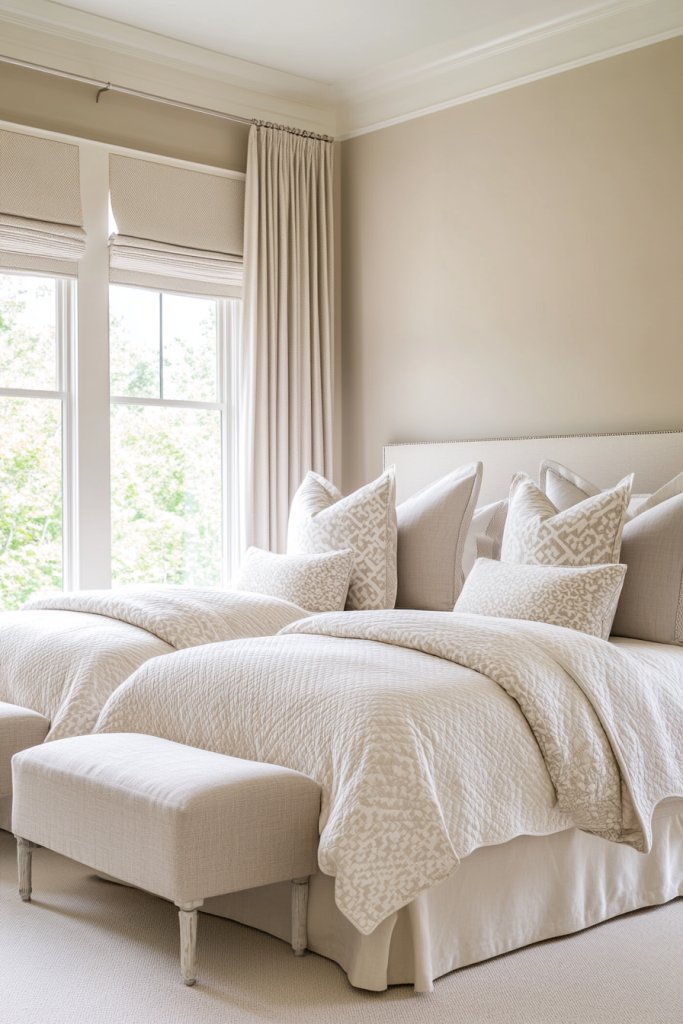
Ever feel overwhelmed by a cluttered or mismatched kid’s room? Creating a peaceful, unified space for both a boy and a girl can seem impossible when each has their own style. Parents want harmony without sacrificing individuality, but mixing decor often leads to chaos. A neutral color palette with coordinated bedding offers a simple solution that encourages calm and unity.
Imagine a room painted in soft beige and warm gray tones, with bedding sets in blush and slate that complement each other perfectly. Textured throws and subtle patterns add depth without clashing, creating a cozy, inviting haven. Natural light filters in, highlighting the soothing color scheme and making the space feel open and tranquil. The balanced palette ties the room together, making it feel harmonious and thoughtfully designed.
This neutral approach adapts easily to changing tastes—add pops of color with accessories or seasonal accents. For a more vibrant look, incorporate subtle patterns or different textures like linen and cotton. For smaller rooms, lighter hues can make the space appear larger, while darker shades add warmth in colder months. Whether you prefer minimalism or layered textiles, this scheme is versatile enough to suit any style.
Start by choosing a calming base color such as beige, gray, or cream for walls and large furniture pieces. Select bedding in coordinating shades—think blush, light blue, or muted greens—that complement the base. Use soft, textured fabrics like cotton, linen, or subtle knits for bedding and throws. Keep accessories minimal but cohesive: matching pillowcases, borders, or piping help unify the look. Incorporate natural materials like wood or woven baskets to enhance the calming vibe.
Add personal touches through small decor elements—think monogrammed pillowcases or personalized name plaques. Incorporate different textures in bedding and blankets to reflect each child’s personality while keeping the overall color scheme consistent. Seasonal swaps, like swapping pillow covers or throws, keep the room fresh without breaking cohesion. Consider a shared decorative element, like a textured wall hanging, to tie everything together.
A neutral, coordinated bedroom proves that harmony and personalization can coexist beautifully. It creates a peaceful retreat that promotes restful sleep and balanced energy. Plus, this timeless palette allows for easy updates as kids grow or style preferences change. Ready to embrace calm and cohesion? Your kids’ shared space can be both stylish and serene!
2. Dual-Function Bunk Beds with Personalized Touches
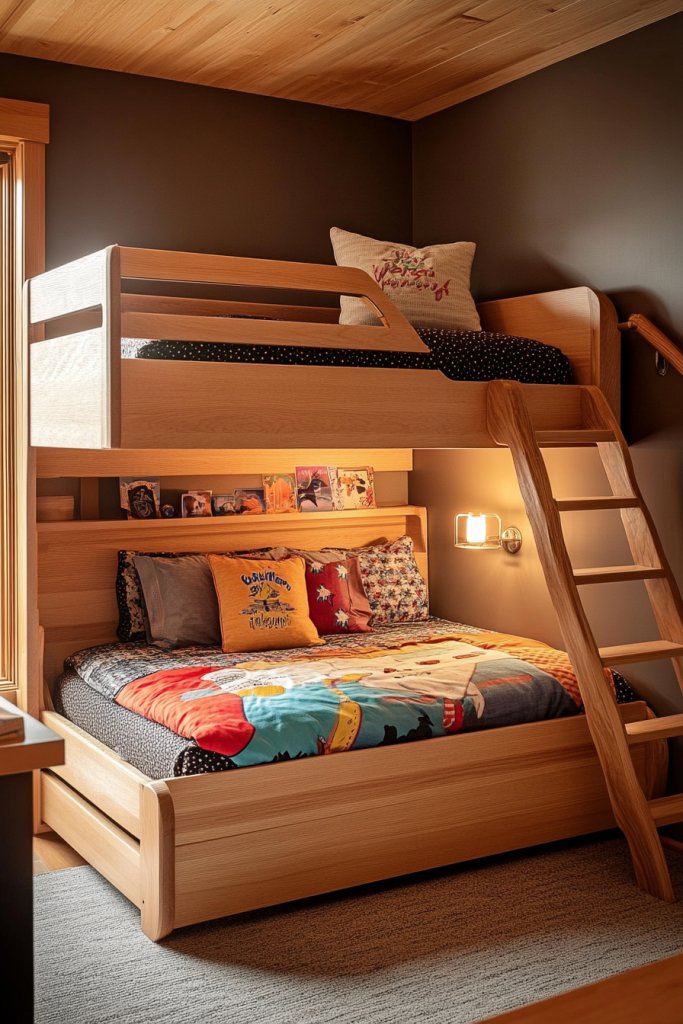
Limited space often makes sharing a bedroom feel cramped and uncomfortable. Bunk beds are a classic solution, but standard models can feel impersonal and boring. Parents and kids alike crave a setup that saves space but still feels personalized and fun. Dual-function bunk beds with customizable features bridge this gap perfectly.
Picture a sturdy wooden bunk with each bed’s headboard painted in different colors, reflecting each child’s personality. Built-in reading lights and storage drawers keep clutter at bay, while personalized name plaques or decals add a special touch. The beds are arranged to maximize floor space, with a shared ladder that feels sleek and integrated. The result is a functional yet playful centerpiece that feels uniquely theirs.
Opt for metal frames for a modern look, or choose natural wood for a warm, rustic vibe. Customize headboards with themes like space or jungle, or personalize with favorite colors and patterns. Add under-bed storage or pull-out desks to increase functionality. For a more playful atmosphere, incorporate fabric curtains or canopy-like covers to create cozy nooks.
Start by selecting a bunk bed frame that fits your space—measure carefully to ensure enough clearance. Personalize the headboards with peel-and-stick decals, paint, or fabric-covered panels. Install individual reading lights and small shelves for each child’s books or toys. Use storage drawers or baskets underneath for clothes, toys, or extra bedding. Safety is key: ensure sturdy rails and secure ladders; consider wall anchors for stability.
Involve your kids in decorating their beds—let them choose colors, themes, or decals. Use different bedding sets or textured throws to reflect their interests. Add personalized accessories like name plaques or themed posters nearby. Incorporate soft rugs or cushions nearby to create inviting little zones within the room.
Custom bunk beds turn a space-saving solution into a personal sanctuary. Kids love having their own space, and parents appreciate the organized layout. It’s a win-win that nurtures individuality while keeping the room functional. Show your kids how thoughtful design can make shared spaces special and fun!
3. Wall-Mounted Shelving for Personal Storage and Decor
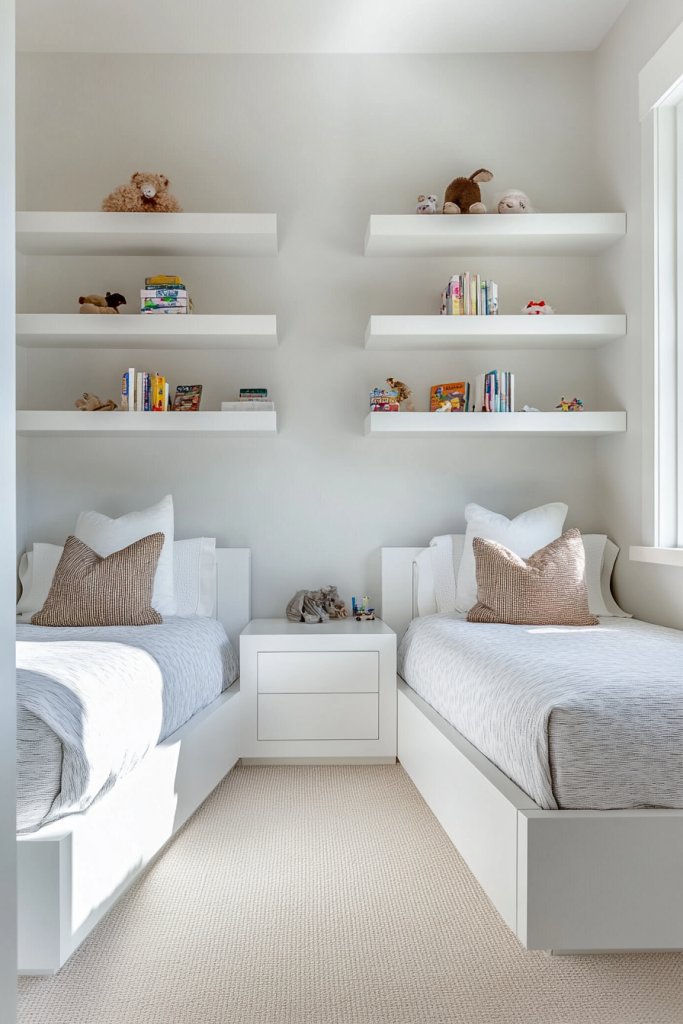
Cluttered floors and crowded surfaces can make a shared bedroom feel chaotic. Kids need space to store their favorite books, toys, or personal items without sacrificing style. Wall-mounted shelving offers an elegant solution that keeps essentials within reach while maintaining a clean look. Plus, it adds a touch of personality to the room.
Imagine sleek, floating shelves painted to match the wall color, lined with colorful books, small decorative boxes, or framed photos. Each child’s shelf is personalized with their favorite items, creating a mini gallery that showcases their personality. The shelves hover effortlessly, giving the room an airy, organized feel. Brightly colored bins or baskets can be tucked into the shelves for extra storage, making everything look tidy but accessible.
Use a mix of open shelves and closed cabinets to balance display and hidden storage. Adjust shelf heights depending on what’s stored—lower for books, higher for decor or collectibles. For a playful touch, incorporate themed shelves or irregular shapes. Seasonal decor or changing favorite items keep the display fresh without cluttering surfaces. Make sure to anchor shelves securely to handle weight and prevent accidents.
Start by choosing sturdy wall brackets and shelves that fit your decor. Plan the layout—place shelves above beds or desks, or in corners for maximum space efficiency. Decorate with a combination of books, small storage boxes, and decorative items aligned with each child’s interests. Use wall anchors if mounting into drywall for safety. Regularly declutter and rotate items to keep the shelves engaging and functional. Consider adding LED strip lighting underneath for a soft glow.
Personalize each shelf with themed containers or decals that reflect your kids’ hobbies or passions. Use labels or color coding to help them organize their belongings. Incorporate fun, textured storage options like fabric baskets or woven boxes. Mix in some DIY elements, like painted wooden signs or handmade crafts, to add a personal touch that’s easy to update over time.
Wall-mounted shelves turn vertical space into a showcase of personality and creativity. They teach kids organization skills while keeping the room tidy. Plus, the room feels larger with fewer bulky furniture pieces. It’s a simple upgrade that makes a big difference—time to get those shelves up and let your kids’ personalities shine!
4. Symmetrical Bedside Tables with Differentiated Accessories
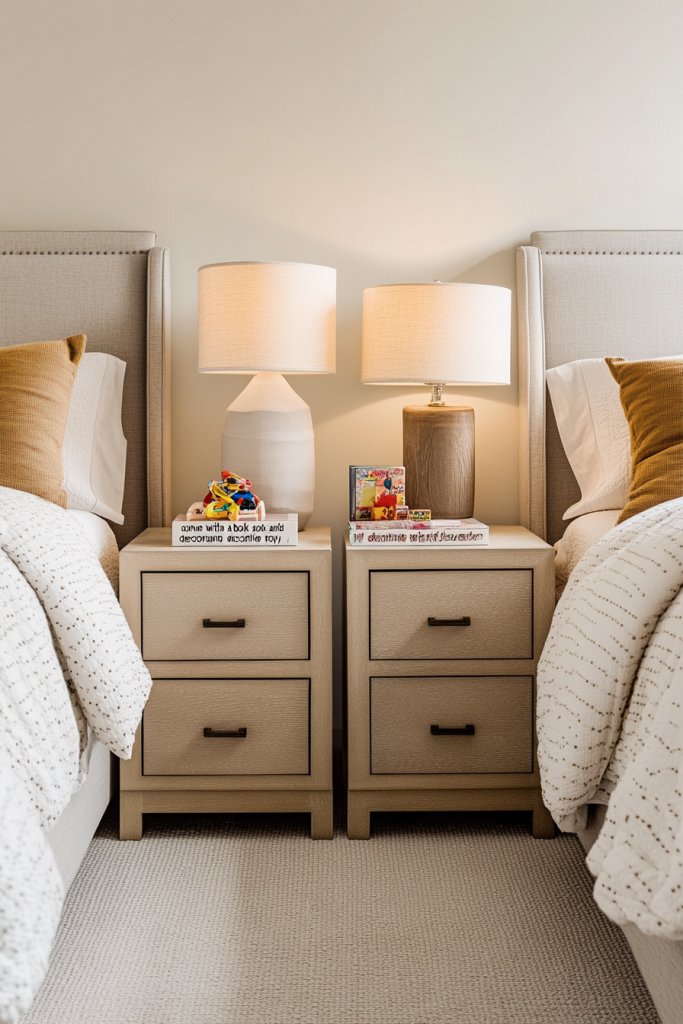
Having two kids share a room often leads to imbalance—one side might feel cluttered, the other too sparse. Symmetrical bedside tables create visual harmony, but without personalization, they can seem too uniform. The challenge is to keep the balance while showcasing each child’s unique style. Simple accessories can make all the difference.
Picture matching nightstands in a neutral wood tone, each topped with a different lamp—one in a fun color, the other in a sleek metallic finish. Add a clock, a favorite toy, or a small framed photo on each table to reflect individual personalities. The symmetry provides order, while the accessories introduce personality. A coordinated color scheme in the accessories ties the look together, making the room cohesive yet lively.
Use matching tables but vary the style—one modern, one vintage—for an eclectic look. Change accessories seasonally or according to interests—sports gear, art supplies, or favorite characters. Incorporate different lamp styles or add small plants (if you’re into greenery—see Step 8!) for variety. Keep the overall design balanced by using similar heights and color palettes.
Choose matching bedside tables that fit your room size and style. Decorate each with a unique lamp, clock, or decorative item that resonates with each child. Use similar color themes—like matching shades of blue or pink—to tie the accessories together visually. Keep surfaces clutter-free by using small trays or organizers. Regularly rotate or update accessories to keep the look fresh and interesting.
Encourage kids to pick out their own accessories—favorite toys, photos, or artwork—to make their space truly theirs. Use themed accessories that match their hobbies or interests. Add decorative textiles like small cushions or textured throws to enhance the look. Personal touches like monogrammed items or custom decals can add a special feel.
Symmetrical nightstands provide a sense of order that’s calming for kids. Personalizing each side fosters independence and pride. It shows that balance can be both functional and fun. Time to style those tables and watch the room come alive with personality!
5. Coordinated but Distinct Themed Bedding for Individuality
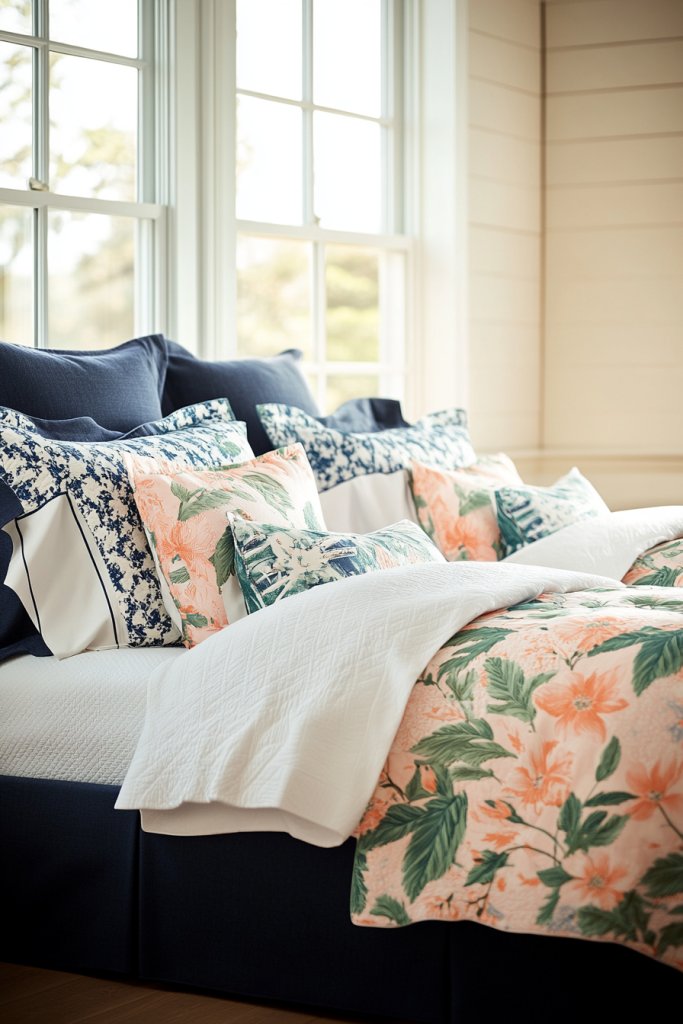
Sharing a bedroom but wanting to express individual personalities can be tricky. Matching bedding might seem too uniform, while completely different styles risk clashing. The solution? Coordinated themed bedding that reflects each child’s interests while maintaining visual harmony. It’s the perfect balance between unity and personal expression.
Imagine one bed dressed in a space-themed duvet with stars and rockets, while the other features a jungle motif with lush greens and animals. The colors complement each other—deep navy with vibrant greens—and create a cohesive look. Textured blankets, themed pillowcases, and decorative trims add layers of personality. The overall room feels lively yet unified, with each bed telling its own story.
Mix and match themes like nautical and adventure, or sports and fantasy, to suit interests. Use complementary color palettes—cool tones with bright accents or pastel shades with bold patterns. Incorporate seasonal or hobby-inspired accessories for variety. For small rooms, choose subtle themes with matching base colors, then add personality with pillows or throws.
Start by selecting bedding sets that reflect each child’s passions—look for coordinated patterns or complementary colors. Mix textures like smooth cotton with chunky knits or silky fabrics for contrast. Add themed pillows, throws, or decorative trims that tie into each theme. Keep the bedding easy to wash and durable for active kids. Coordinate the decor around the bedding for seamless style.
Let kids choose their favorite colors, characters, or motifs to incorporate into their bedding. Swap out pillowcases or duvet covers seasonally for freshness. Add small decorative pillows or textured throws that reflect their hobbies or dreams. Personalize with embroidered initials or custom patches for a special touch. Keep everything coordinated but allow room for individual flair.
Themed bedding encourages kids to express their interests confidently. It makes their space feel uniquely theirs, boosting pride and ownership. Plus, coordinated designs simplify decorating—no more endless mismatched sets. Your kids will love coming home to a room that celebrates their individuality within a harmonious design!
6. Use of Light and Dark Shades for Visual Contrast and Unity
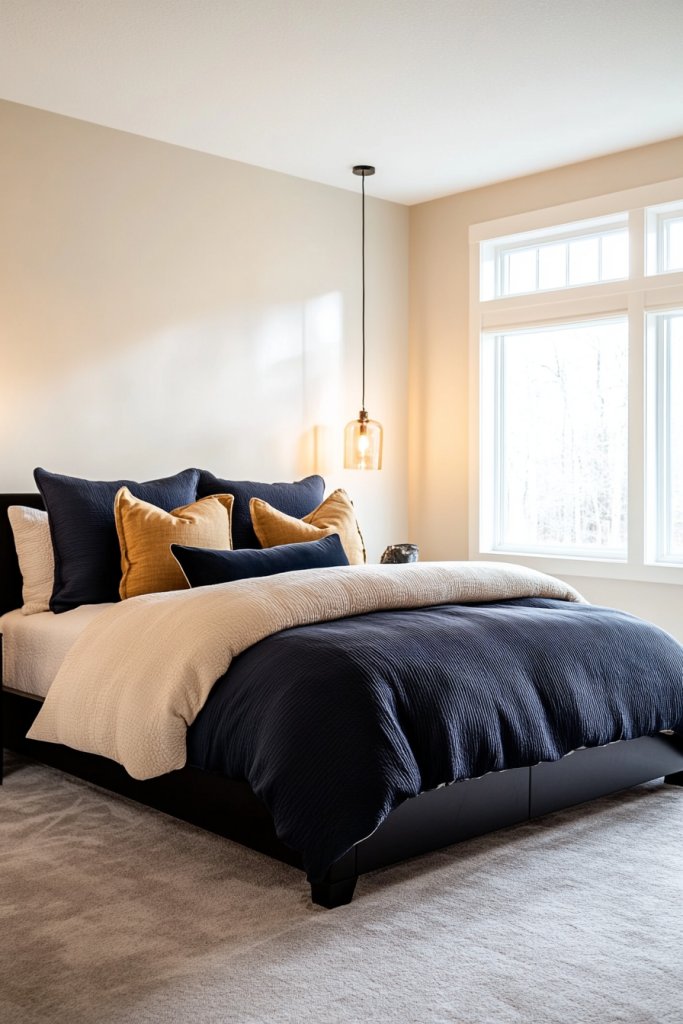
A room that’s all light or all dark can feel flat or overwhelming. Finding a balance between contrasting shades adds depth and interest without chaos. Light and dark shades can create visual harmony while emphasizing specific areas or features. It’s a simple trick to elevate a shared bedroom into a stylish sanctuary.
Picture soft blush walls contrasted with charcoal bedding and dark wooden furniture. Light-colored curtains or bedding brighten the space, while darker accents ground the room. Textured fabrics in different shades add dimension—think a light cream throw on a dark bed, or a dark pillow against a light sheet. The interplay between shades enhances both comfort and style, making the room look thoughtfully curated.
Use pastel shades with rich, dark tones for a balanced look—mint with navy, or peach with deep plum. Change the emphasis depending on the room’s natural light—darker shades work better in rooms with ample sunlight, while lighter shades brighten smaller or darker spaces. Metallic accents in fixtures or decor can also add a subtle contrast. Seasonal decor can be swapped to emphasize different shades, keeping the room fresh.
Start with a neutral base for walls or large furniture pieces. Introduce darker shades in bedding, rugs, or accent furniture, and balance with lighter elements in curtains, cushions, or throws. Play with contrasting textures—smooth silk against plush velvet—to add visual interest. Use color-coordinated accessories to tie the shades together. Keep a consistent theme or palette to avoid clashing and maintain harmony.
Incorporate favorite colors or themes into the shades—like a deep blue for a sea lover or a soft pink for a dreamer. Use different fabric textures or patterns within the contrast to add richness. Mix metallic or matte finishes to create subtle variety. Personalize with monograms or themed decorative accents that complement the overall color scheme.
Using contrast in shades adds sophistication and visual intrigue to a shared space. It demonstrates that harmony isn’t about uniformity but about balancing different elements. With thoughtful use of light and dark, your kids’ room will feel dynamic and balanced—an inspiring environment for growth and relaxation.
7. Shared Desk Area with Separate Workspaces
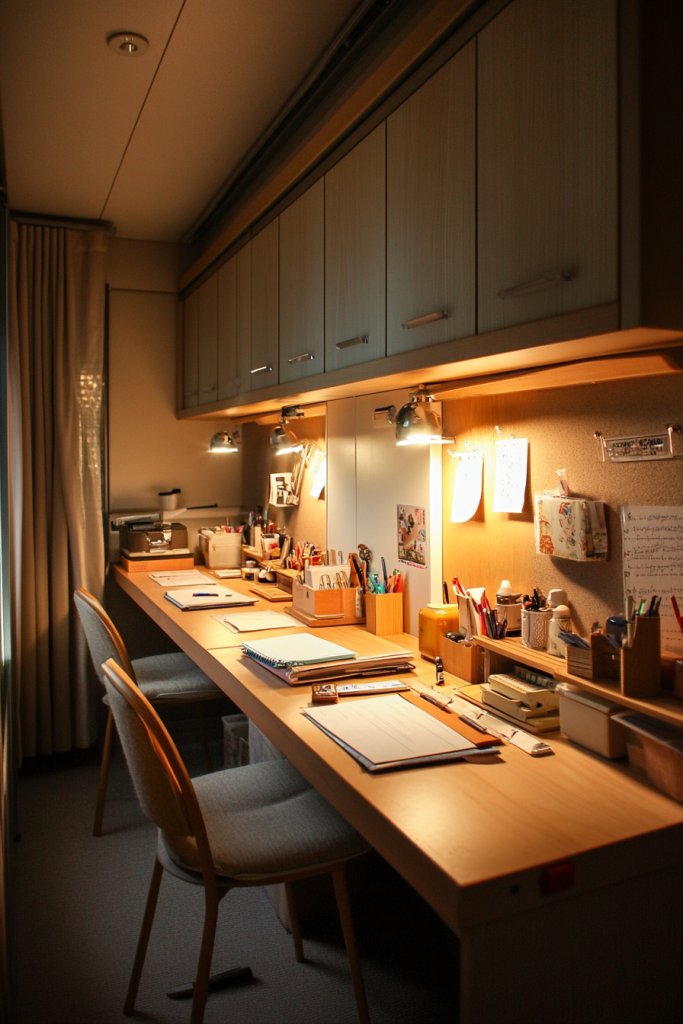
Sharing a desk in a small room often leads to chaos, distractions, and arguments. Kids need their own dedicated space to focus, study, and be creative without interference. But how do you create a functional shared workspace that respects individual needs? The answer lies in designing separate zones within a shared area.
Envision a long, sleek desk divided by a decorative partition or a set of open shelves, with each side personalized with different organizers and accessories. One child’s side might feature colorful pencil cups and motivational posters, while the other’s has sleek, minimalist organizers. Bright task lighting and comfortable chairs make each workspace inviting. The room feels organized and intentional, with clearly defined areas for each kid to thrive.
Use dividers like fabric screens, open shelving, or even plant-free, decorative panels to create separation. Choose desks with adjustable heights or modular components to suit different ages. Incorporate personal touches—favorite colors, themes, or organizational accessories—to reflect each child’s personality. For smaller spaces, wall-mounted fold-away desks or corner setups work well.
Start by selecting a long, sturdy desk or two smaller desks pushed together. Install dividers or shelves that don’t block light or movement. Assign each child a dedicated area with their preferred tools—pens, notebooks, or tech accessories—organized in containers or drawers. Use matching chairs with ergonomic support for comfort. Keep the workspace clutter-free with daily tidying routines. Consider adding clipboards or magnetic boards for quick notes or schedules.
Let each child decorate their zone with small posters, themed accessories, or favorite colors. Use different organizational tools—like colored bins or labeled containers—to distinguish each side. Incorporate personal tech or study aids, such as a tablet holder or a small clock. Rotate accessories or add seasonal decor to keep the area feeling fresh and motivational.
A well-designed shared desk teaches kids respect for each other’s space and promotes independence. It encourages focus and organization, setting them up for success. Seeing their personalized workspace can boost confidence and responsibility. Ready to craft a study zone that sparks productivity and pride?
8. Incorporation of Soft Textures with Rugs and Throw Pillows
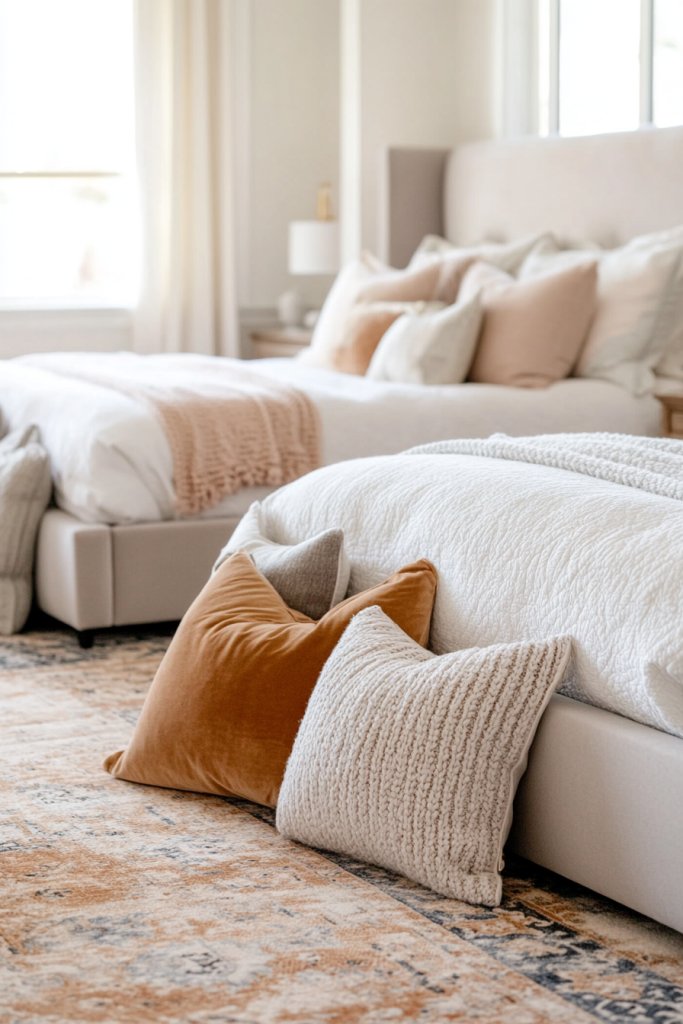
A hard, sterile room can feel cold and uninviting, especially in a shared space for kids. They need a cozy environment that invites relaxation, play, and sleep. Soft textures like rugs and throw pillows add warmth and comfort, making the room a true retreat. But how do you balance practicality with plushness?
Picture a plush, shaggy rug in warm beige covering the main sleeping area, with colorful throw pillows scattered on beds and chairs. The textures invite kids to sit, cuddle, or play comfortably. A mix of plush, woven, and knitted fabrics creates visual depth and tactile interest. The room feels layered, warm, and welcoming, encouraging kids to unwind and enjoy their shared space.
Choose rugs with playful patterns or neutral tones depending on your style. Layer rugs for added texture and dimension, especially in larger rooms. Incorporate textured throw pillows in different shapes and fabrics—think faux fur, chunky knits, or soft velvet—to reflect each child’s personality. Seasonal textiles, like fleece or velvet, can add extra warmth during colder months. Keep cleaning in mind—machine-washable options are best for active kids.
Start with a durable, comfortable area rug that covers the main zones. Add a variety of throw pillows in different textures and sizes for beds, chairs, or reading nooks. Use fabric covers or slipcovers that are easy to wash and change. Mix textures—think boucle, faux fur, or woven materials—to create a rich, layered look. Keep accessories within easy reach, and regularly rotate or wash textiles to maintain freshness.
Let each child select their favorite colors or textures for pillows and blankets. Incorporate themed cushions or textured throws that reflect hobbies or interests. Use decorative, textured blankets on beds or chairs for added visual appeal. Personalize with embroidered initials or custom patches on pillows. These small touches make the room feel uniquely theirs and super cozy.
Soft textures transform a room into a comforting haven that nurtures relaxation and creativity. Kids will love snuggling into plush pillows and soft rugs, making the space feel safe and inviting. It’s a simple way to elevate the room’s style while promoting well-being. Time to add those plush layers and make your shared bedroom irresistibly cozy!
9. Use of Vertical Space with Overhead Storage Solutions
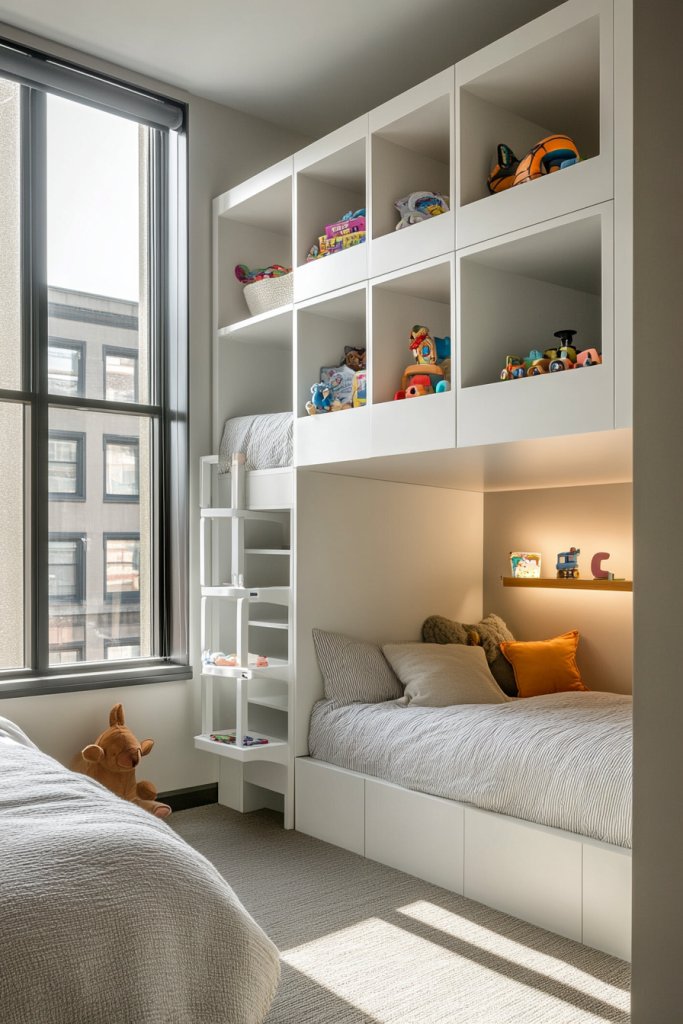
Floor space in a shared bedroom can quickly become cluttered and cramped. Kids need storage solutions that free up surface area and keep things organized. Overhead storage is a fantastic way to utilize vertical space, keeping essentials out of the way but easily accessible. The challenge is finding stylish, safe options that suit a child’s room.
Visualize sleek wall-mounted bins or hanging organizers above beds or desks, holding toys, supplies, or seasonal clothing. Use colorful fabric pockets or minimalist baskets to add a fun pop of color or texture. With the right placement, these storage units appear almost invisible, yet they dramatically increase functionality. The room feels open and tidy, with everything in its place.
Choose from open shelves, fabric pockets, or hanging baskets depending on style and needs. For added decoration, pick vibrant colors or patterns that complement the room’s theme. Install adjustable systems for flexibility as kids grow. Use hooks or rails to hang personal items, like backpacks or jackets, for quick access. Keep safety in mind—secure all units firmly to prevent accidents.
Start by measuring available wall space and selecting suitable overhead storage units. Install sturdy brackets or rails, following manufacturer instructions carefully. Organize items into labeled bins or baskets for easy retrieval. Hang frequently used items at lower heights for quick access. Regularly review and declutter to maintain order. For a polished look, coordinate the storage units with the room’s color palette.
Let kids choose their favorite colors or patterns for storage solutions, making organization fun. Label bins with their names or icons for easy recognition. Incorporate themed containers—like sports or animal motifs—that reflect their personalities. Use decorative hooks or stickers to customize the look further. This encourages responsibility and ownership over their space.
Vertical storage solutions optimize space and teach kids the value of organization. When everything has a designated spot, clutter reduces, and focus improves. Kids feel more in control of their environment, fostering independence. It’s a simple upgrade that makes a big difference—time to elevate your room’s storage game!
10. Modular Storage Units for Flexible Organization
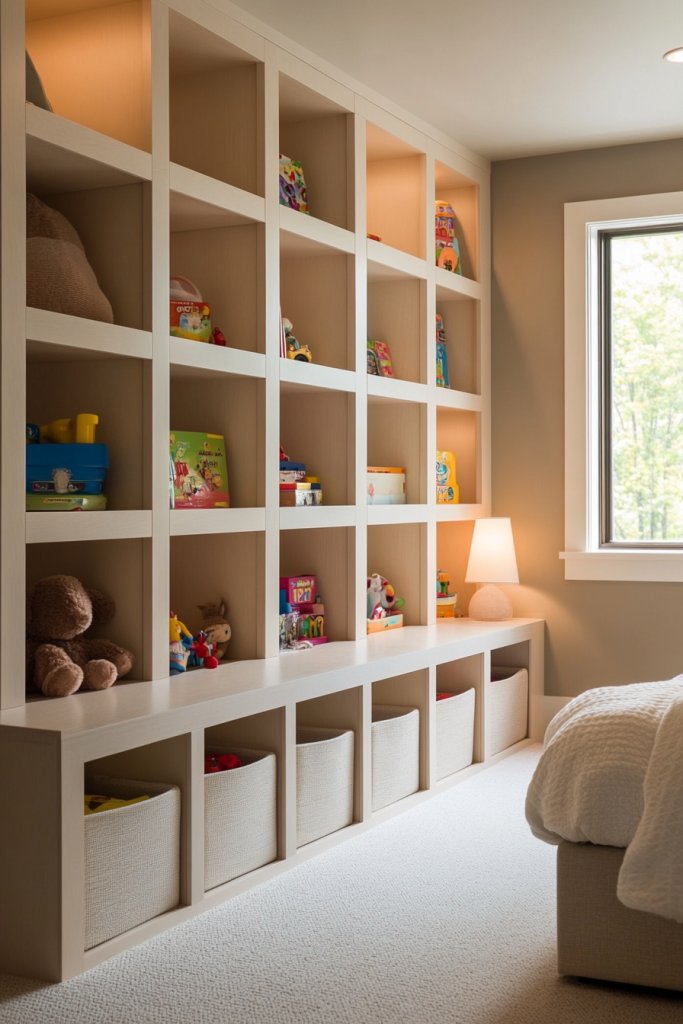
Kids’ interests and belongings change fast, making fixed storage solutions feel limiting. Modular storage units adapt to evolving needs, offering flexibility and practicality. They allow you to customize the room layout and storage capacity without a complete overhaul. Who doesn’t love a bit of upgradeability in a shared space?
Picture cube-shaped units in bright colors or natural wood, stacked or arranged in different configurations. Use baskets, bins, or open compartments within each module for toys, clothes, or books. The modular design creates a playful, organized look that can be easily expanded or reconfigured as needed. This setup adapts seamlessly from toddler to teen stages, growing with your kids.
Mix and match different-sized cubes or shelves to suit various storage needs. Incorporate wheels for easy rearrangement or portability. Use fabric bins or decorative boxes to add color and texture. Create themed zones—like a reading nook or craft corner—by combining modules. For smaller spaces, focus on vertical stacking; for larger rooms, spread units out for visual interest.
Start by choosing a versatile modular system compatible with your space. Assemble units following the instructions, then arrange into your preferred configuration. Use labeled bins or baskets within each module for easy access and organization. Customize with decorative elements like stickers or fabric covers. Regularly evaluate and reconfigure to accommodate changing interests or storage needs. Keep the arrangement practical and fun.
Let kids pick their favorite colors or themes for their storage bins or boxes. Add labels with their names or icons to foster independence. Incorporate special items like a small chalkboard or corkboard within a module for personal expression. Reorganize periodically to keep the setup fresh and engaging. The flexibility encourages responsibility and creative use of space.
Modular storage empowers kids to organize their belongings independently. As they grow, the system adapts, making it a long-term solution. It teaches adaptability and planning skills—valuable lessons for life. Plus, it keeps the room looking tidy and stylish—what’s not to love?
11. Colorful Accent Wall as a Focal Point
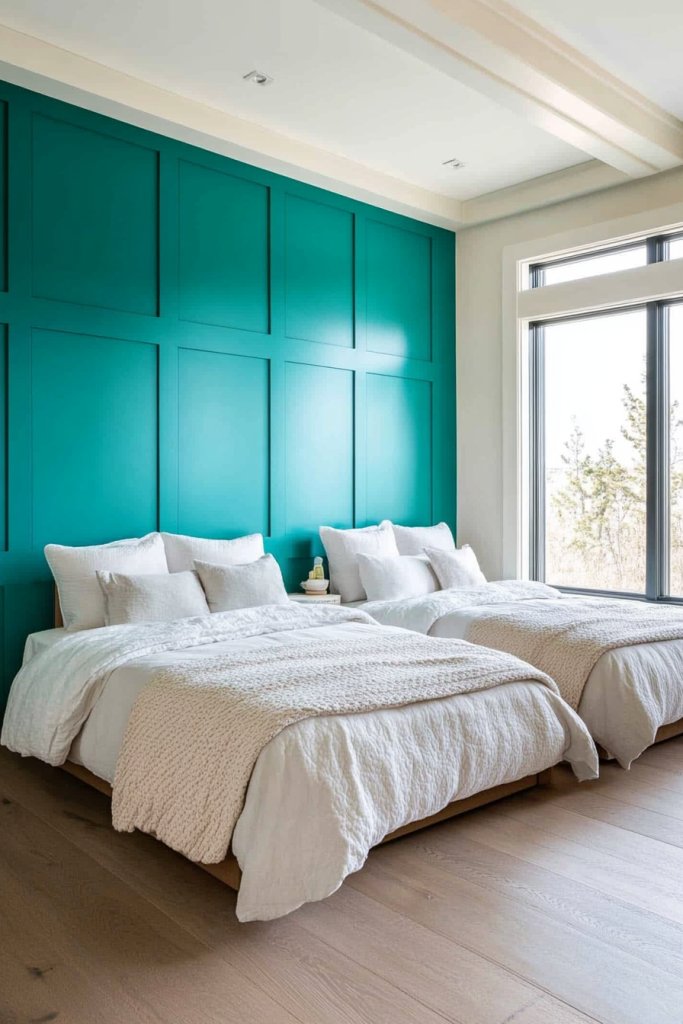
A plain wall can make a bedroom feel dull and uninspired, especially when sharing with a sibling. Adding a bold accent wall creates a visual focal point that energizes the space. It’s a simple way to inject personality and color without overwhelming the room. But how do you choose the right hue and design?
Imagine one wall painted in a vibrant teal or mint green, contrasted with softer neutrals elsewhere. Patterns like stripes, geometric shapes, or murals can add excitement while maintaining harmony. Textured wallpapers or chalkboard paint offer interactive elements for kids to draw and express themselves. The accent wall draws the eye and anchors the room’s design, making it feel lively and cohesive.
Choose colors that match the kids’ personalities—bright yellows or playful pinks for energetic vibes, muted pastels for a calmer atmosphere. Change the accent wall seasonally or as interests evolve, using removable wallpaper or paint. Incorporate fun patterns or textures to add depth. For small rooms, an accent wall can create the illusion of depth and dimension.
Select a wall that naturally becomes the room’s centerpiece—behind beds or desks. Prepare the surface, ensuring it’s clean and smooth. Use painter’s tape for clean lines if painting or choose peel-and-stick wallpaper for easy updates. Choose a bold or playful color that complements the rest of the decor. Finish with protective clear coats or removable adhesives for easy changes. Keep the design simple but impactful.
Let kids choose their favorite colors or patterns for the accent wall. Incorporate themed decals or geometric stencils for added interest. Use the wall to display their artwork or achievements temporarily with removable hooks or clips. Add complementary accessories—like matching bedding or decor—that tie into the wall’s theme. It’s a statement piece that can evolve with your kids.
A bold accent wall transforms a room from ordinary to extraordinary, inspiring creativity and pride. It shows that decorating can be fun and expressive. When kids see their personality reflected in their space, it boosts confidence and ownership. Ready to make a statement that’s both playful and stylish?
12. Adjustable Lighting with Shared and Personal Light Sources
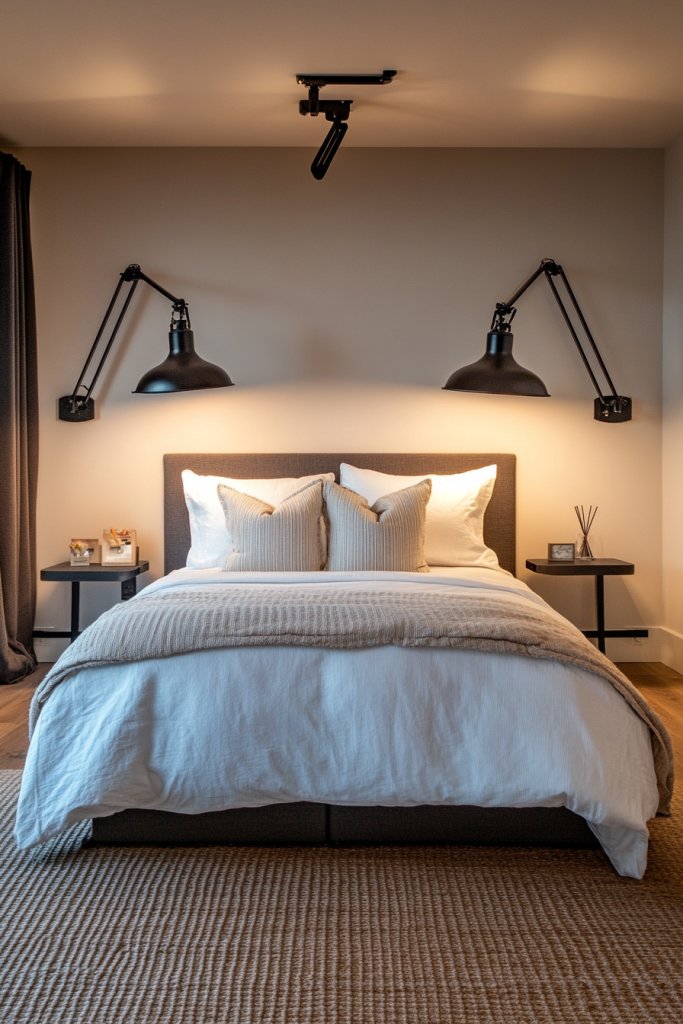
Shared bedrooms often struggle with lighting that suits everyone—bright enough for homework, cozy enough for bedtime. Fixed lighting fixtures don’t always meet individual needs, leading to frustration. Adjustable lighting solutions allow each kid to control their environment, making the room more functional and personalized. But how do you strike a perfect balance?
Imagine overhead LED lights with dimming controls complemented by flexible clip-on reading lamps on each bed. Each child can set their preferred brightness and tone—warm for relaxing, bright for studying. Soft ambient lighting creates a calming atmosphere at night, while task lighting keeps homework sessions focused. The layered lighting setup feels both modern and adaptable, enhancing the room’s overall vibe.
Choose smart bulbs compatible with voice or app control for easy adjustments. Incorporate different styles—sleek wall-mounted sconces, portable clip-on lamps, or fairy lights for ambiance. Use dimmers or adjustable color temperature bulbs to customize lighting based on activity or mood. For a fun touch, add themed covers or colored filters. Flexibility is key—adapt lighting to the room’s changing needs.
Install dimmable overhead fixtures or smart lighting systems that can be controlled remotely. Equip each bed with clip-on reading lamps or flexible goosenecks for targeted illumination. Use extension cords and outlets thoughtfully to avoid clutter or hazards. Program smart bulbs for preset scenes—cozy, study, or sleep modes. Regularly check and update lighting settings to suit evolving routines and preferences.
Let each kid choose their preferred light color or brightness level. Add decorative lampshades, themed covers, or colored filters to match their personality. Encourage them to personalize their lighting scene for different activities—reading, relaxing, or sleeping. Incorporate nightlights or subtle glow-in-the-dark elements for nighttime comfort. It’s about empowering kids to create their ideal environment.
Adjustable lighting fosters independence, giving kids control over their space. It promotes better sleep routines and focus, making the room more functional. Seeing their room adapt easily to their mood or activity builds confidence in their choices. Brighten up your shared bedroom with smart, customizable lighting and watch the ambiance transform!
13. Fun and Functional Themed Bedding in Playful Styles
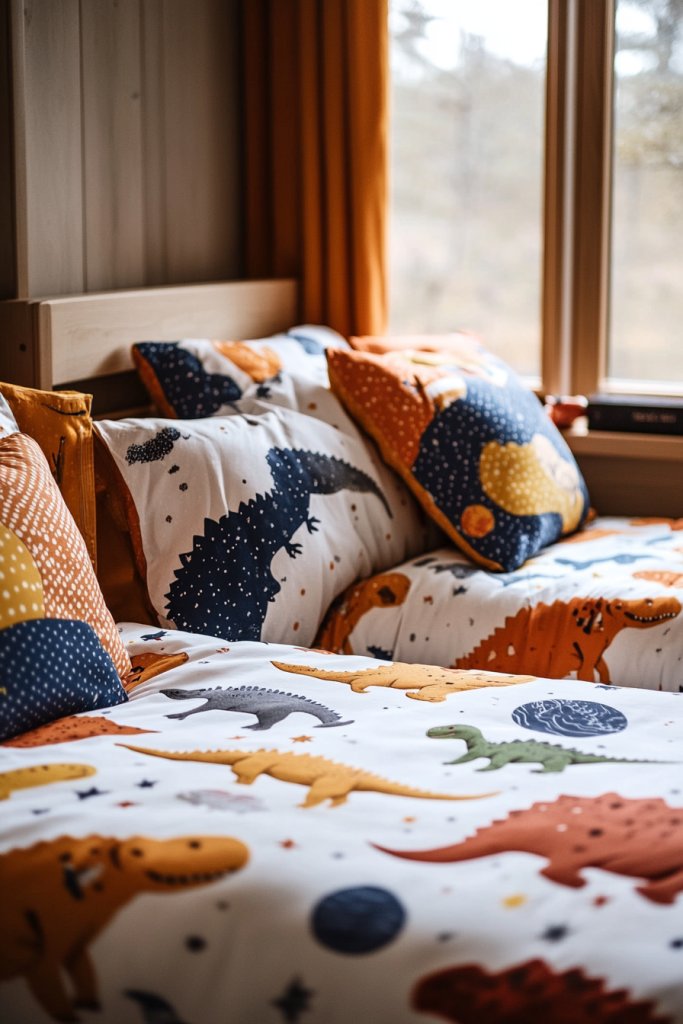
A plain bedspread can make a shared bedroom feel dull and uninspiring. Kids love themed bedding that reflects their interests and sparks their imagination. Fun, playful styles add personality and make bedtime more exciting. But how do you balance themes with practicality?
Picture beds dressed in nautical stripes and cheerful space prints, layered with matching pillows and blankets. Bright colors and bold patterns create a lively, inviting atmosphere. The themed bedding complements the room’s decor, tying everything together visually. Kids feel connected to their favorite themes, making their space feel special and personalized.
Mix themes—like jungle and ocean—or keep it simple with a cohesive color palette. Use reversible duvet covers or removable pillowcases for easy updates. Incorporate textured throws or plush cushions for added comfort. Seasonal or hobby-based themes keep the decor fresh and engaging. Choose durable, machine-washable fabrics to withstand active kids and frequent laundry.
Start by selecting bedding sets that match your chosen themes or color schemes. Mix and match textures—cotton, fleece, or velvet—to add richness. Add themed accessories like pillows or plush toys that complement the bedding. Keep the bedding easy to wash and maintain, especially with energetic children. Coordinate the room decor around the bedding style for a harmonious look. Regularly rotate or switch out designs to match evolving interests.
Let kids pick their favorite themes or characters—think dinosaurs, princesses, or superheroes. Add personalized touches like embroidered initials or custom patches. Incorporate textured or layered bedding to add depth. Encourage kids to decorate with their own artwork or small accessories that match the theme. This approach makes bedtime fun and fosters a sense of ownership.
Themed bedding turns the bedroom into a playful retreat that kids love to personalize. It sparks their imagination and makes routines enjoyable. When children feel connected to their space, they develop pride and independence. Ready to create a vibrant, themed haven for your kids?
14. Use of Functional Storage Benches at the Foot of Beds
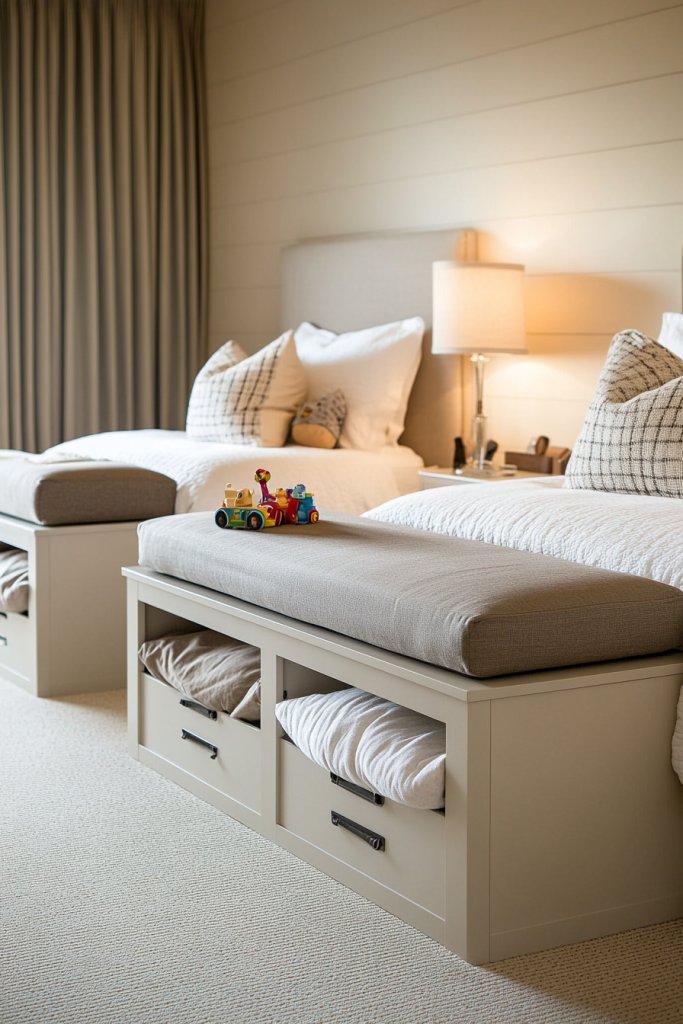
Clutter at the foot of beds can make a room look messy and cramped. Kids need a practical way to store toys, clothes, or bedding without sacrificing style. Storage benches are perfect—they double as seating and hidden storage, keeping the room tidy and inviting. But how do you choose the right one?
Visualize a sturdy wooden bench painted in bright colors or natural finish placed at the foot of each bed. The top doubles as seating for reading or relaxing, while the interior hides toys and extra linens. Decorate the bench with cushions or textured throws that match the room’s theme. The space looks organized, playful, and functional—making cleanup easier and more fun.
Choose benches with lids, drawers, or open compartments depending on storage needs. Decorate with themed cushions or colorful fabric to match the room’s decor. Use multi-purpose styles—like ottomans that can fold out into beds for sleepovers. For smaller rooms, opt for slim, space-efficient designs. Incorporate wheels or lift-up lids for convenience.
Select a storage bench that complements the room’s style and size. Position it at the foot of the bed, ensuring it doesn’t obstruct pathways. Fill it with frequently used items—extra bedding, toys, or shoes—organized in bins or baskets inside. Decorate the lid with fabric or paint for a personalized touch. Keep the area clutter-free by regularly tidying and reorganizing contents. Consider adding a small cushion for extra comfort.
Let kids choose the fabric or color of the bench to reflect their personality. Add embroidered initials or themed fabric patches for a custom look. Use decorative cushions or throws to make it inviting. Encourage kids to store items they use daily, fostering responsibility. Seasonal decor or stickers can also be added to keep it lively.
Storage benches make tidying up a fun and rewarding activity. They teach organization skills and responsibility while adding style. Kids love having a designated spot for their belongings that doubles as a cozy seat. It’s an easy upgrade with a big impact—time to add one today!
15. Incorporating Personal Growth Zones with Growth Charts or Bulletin Boards
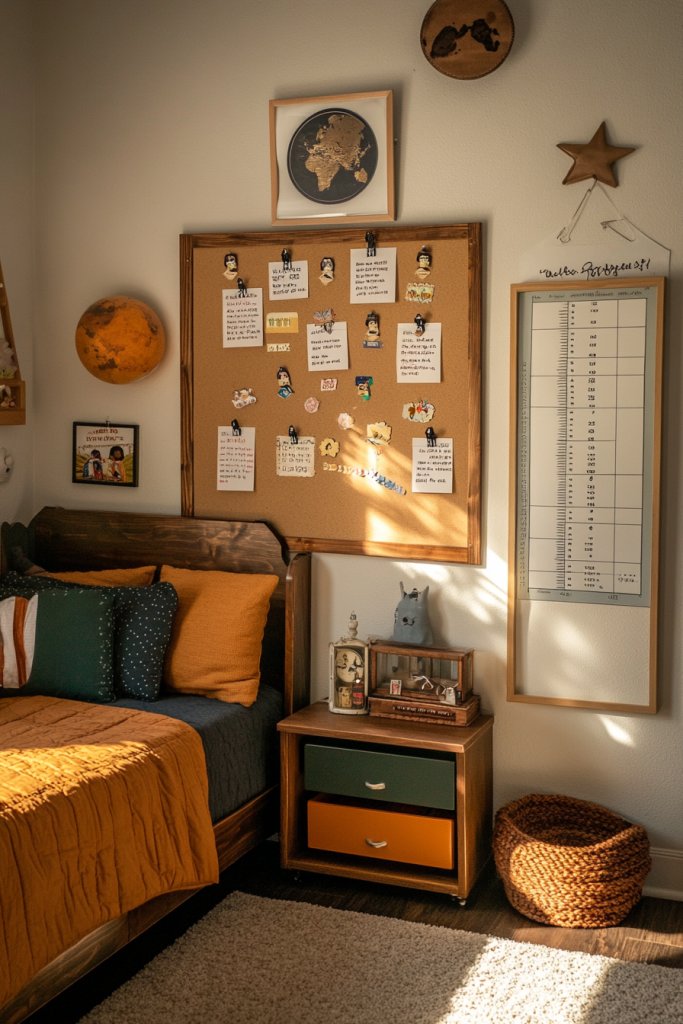
A shared bedroom often feels like a blank canvas, missing opportunities to celebrate growth and achievements. Kids thrive on recognition and visual progress, which boosts confidence and motivation. Personal growth zones, like growth charts or bulletin boards, turn blank walls into inspiring spaces. But how do you make these elements both functional and attractive?
Imagine a colorful growth chart on the wall, marked with milestones and personal notes. Nearby, a bulletin board displays artwork, awards, or daily schedules, framed with fun borders or themed decorations. The room becomes a showcase of progress, encouragement, and personal expression. Bright colors and playful layouts make these zones engaging and inspiring for kids.
Use fabric-covered boards, cork tiles, or magnetic surfaces for versatility. Incorporate themed or color-coordinated frames to match room decor. Change displays seasonally or as kids reach new milestones. Add stickers, washi tape, or decorative clips for easy updates. Keep the layout flexible to grow with your children’s changing interests and achievements.
Choose a prominent wall space and install a sturdy growth chart—either painted directly or as a removable decal. Set up a bulletin board with a fun frame or decorative border. Use push pins or clips to display artwork, certificates, or photos. Encourage kids to add their achievements regularly, fostering pride. Keep supplies like markers, stickers, and clips accessible for frequent updates. Refresh displays to keep motivation high.
Involve kids in decorating their growth zones—choose colors, themes, or frames that reflect their personality. Add small personal touches like name tags or favorite character stickers. Use themed or personalized borders to match their hobbies. Incorporate a small shelf or container nearby for keepsakes or supplies related to the display. Celebrate milestones with small rewards or special displays.
Personal growth zones transform a plain room into a motivational space. They encourage kids to set goals and recognize their achievements, fostering independence. Seeing their progress visually builds confidence and resilience. It’s a simple way to turn everyday spaces into powerful tools for development—ready to inspire your little ones?
16. Coordinated Window Treatments with Unique Patterns or Colors
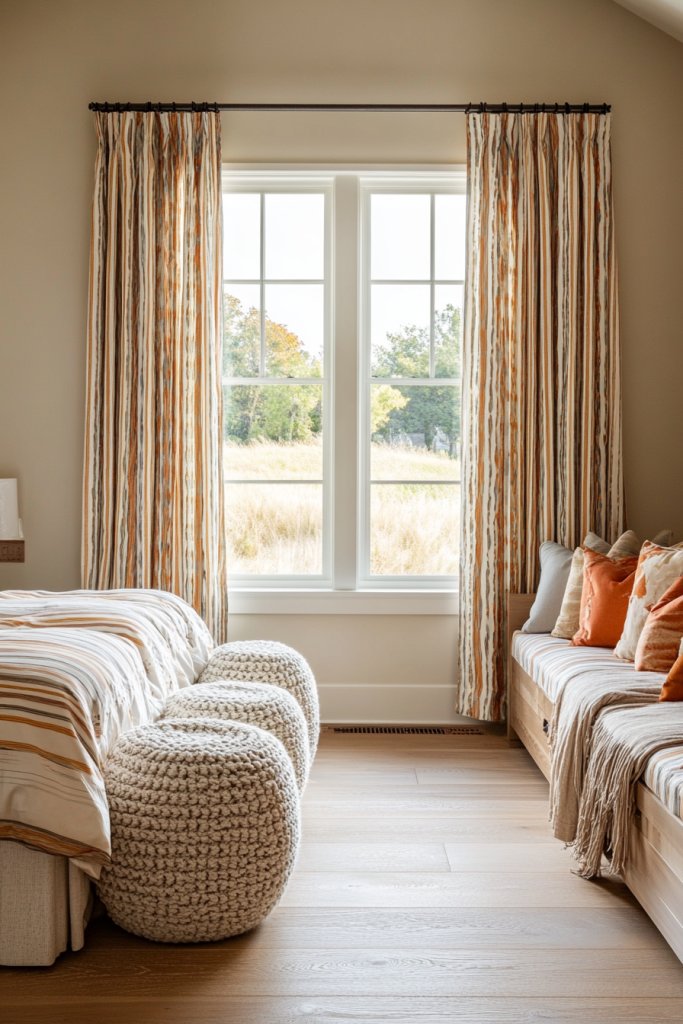
Plain blinds or curtains can make a room look dull and generic. Kids love window treatments that reflect their personalities and add a splash of fun. Coordinated window coverings in matching fabrics or colors tie the room together, but with unique patterns or shades for individuality. How do you balance cohesion with personal flair?
Picture curtains in a soft pastel with subtle polka dots paired with matching blinds in a complementary hue. Alternatively, choose vibrant patterns like stripes, stars, or animals that align with each child’s interests. Layering sheer curtains with blackout shades adds both style and functionality. These treatments frame the windows beautifully, creating a warm, inviting glow and enhancing room decor.
Mix patterns and textures—think floral and geometric—while sticking to a common color palette. Use different shades or patterns for each window to reflect individual preferences. Consider blackout blinds for better sleep or sheer curtains for light filtering. For a playful touch, incorporate themed or textured fabrics that add depth. Regularly update or swap out curtains for seasonal or interest-based changes.
Measure your windows carefully and select curtains and blinds that coordinate but give each kid a sense of personal style. Install curtain rods at the right height to maximize natural light and aesthetic appeal. Use matching or contrasting fabrics to create a balanced look. Hang curtains neatly, ensuring they are long enough to puddle slightly for a luxurious feel or hang clean at the window frame for a modern look. Keep maintenance simple with washable fabrics.
Involve kids in choosing their curtain patterns or colors—perhaps with a fabric swatch or sample. Add decorative tiebacks, trims, or appliqués that match their personality. Coordinate accessories like cushion covers or rugs to complement the window treatments. You can also DIY with fabric paints or tie-dye techniques for a personal touch. These details turn functional window coverings into design features.
Thoughtfully coordinated window treatments create a cohesive room environment that feels polished and inviting. They reflect each child’s style while enhancing overall decor. When kids see their preferences incorporated, they feel valued and confident. It’s a simple update that makes a big visual impact—time to dress those windows!
17. Use of Mirrored Elements to Enhance Light and Space
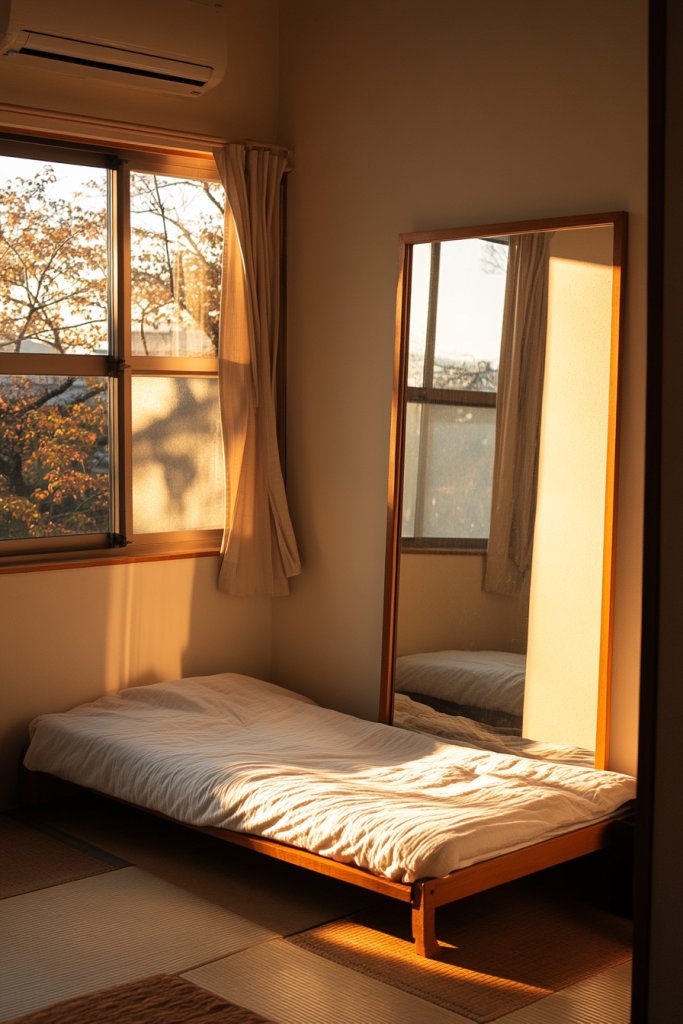
A small or shared bedroom can feel cramped and dark, making it hard for kids to relax or focus. Mirrored elements help reflect light and create the illusion of more space, transforming the room into a brighter, more open environment. But how do you incorporate mirrors without clutter or safety concerns?
Imagine a large mirrored closet door that doubles as a full-length mirror, reflecting a cheerful, well-lit room. Smaller decorative mirrors are placed strategically above desks or beds, catching natural or artificial light. The reflections bounce around, making the room appear larger and more inviting. Soft lighting enhances the effect, creating a bright, airy atmosphere that feels expansive and welcoming.
Choose full-length or decorative wall mirrors depending on space and style. Use framed mirrors with playful or elegant frames that match the decor. Position mirrors to reflect windows or light sources, maximizing brightness. For safety, secure mirrors properly and opt for shatterproof options in kids’ rooms. Incorporate mirrored furniture or accents for a chic, modern touch.
Select mirrors that suit your room’s size and style—full-length for functionality, decorative for flair. Mount mirrors securely using appropriate hardware, ensuring they’re level and stable. Position mirrors across from windows or light sources to amplify brightness. Regularly clean and check for stability, especially in rooms with active children. Use mirrors as focal points or subtle accents to balance the room’s design.
Personalize mirrors with decorative frames, decals, or paint for a customized look. Encourage kids to decorate around the mirrors with stickers or small artwork. Use mirrored furniture like dressers or side tables to add style and function. Incorporate lighting around mirrors—like LED strips—to enhance brightness and ambiance. It’s a practical and stylish upgrade that adds depth and light.
Mirrored elements brighten the room and visually expand the space, making it feel less crowded. They also serve as functional accessories for dressing or grooming. When kids see themselves reflected in a well-designed space, they feel more confident and proud of their environment. It’s a simple yet powerful way to upgrade any shared bedroom.
18. Minimalist Wall Art with Inspirational Quotes or Simple Shapes
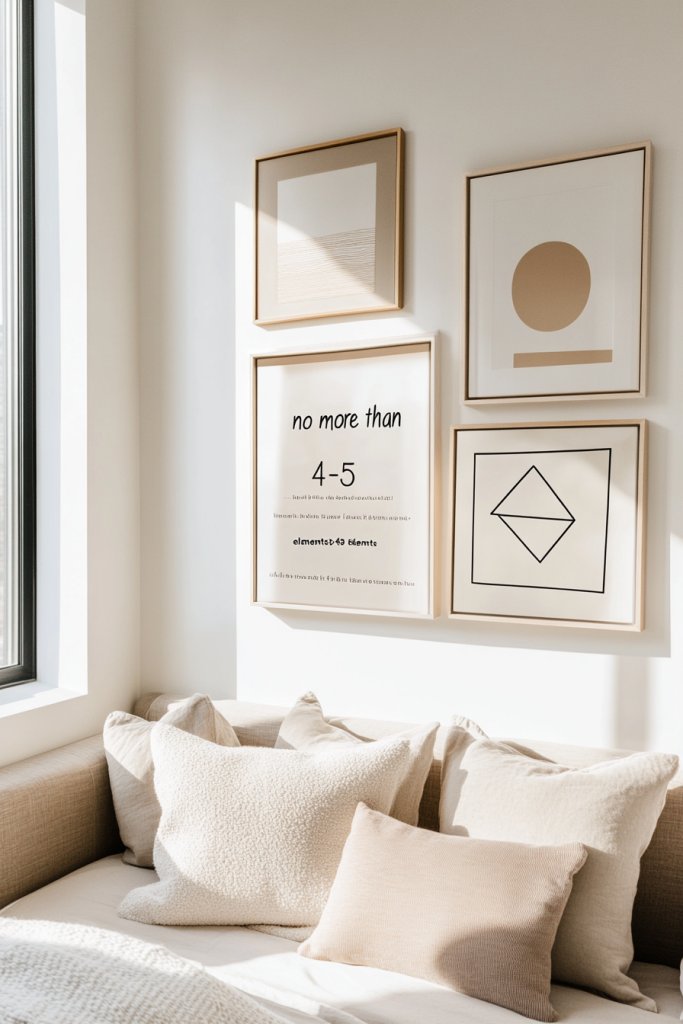
A cluttered or overly busy room can feel overwhelming for kids sharing a space. Minimalist wall art offers a clean, calming aesthetic that promotes focus and peace. Simple shapes or motivational quotes add personality without clutter. But how do you decorate without overwhelming the space?
Picture a single, large geometric print in monochrome or soft pastels above each bed. Alternatively, a quote like ‘Dream Big’ in sleek typography creates motivation. The art is understated but impactful, complementing the room’s decor rather than competing with it. Negative space and simple lines make the room feel open, airy, and thoughtfully designed.
Use black-and-white line art, abstract shapes, or subtle pastel prints to match different styles. Change or rotate art seasonally or as interests evolve. Frame prints in slim, modern frames or directly apply decals for a no-fuss look. Keep the color palette neutral or matching to the room’s overall scheme for cohesion. These simple pieces serve as focal points without clutter.
Choose artwork or decals that reflect your kids’ personalities or aspirations. Keep sizes proportional to wall space—large for impact, small for accents. Use a level to hang art at eye level or create a gallery with a clean, grid layout. Opt for frameless prints or sleek frames to maintain the minimalist aesthetic. Regularly update or add new pieces to keep the decor fresh and inspiring.
Let kids choose their favorite quotes or shapes to display. Incorporate personal symbols or initials into the designs for a custom touch. Use removable decals or frames for easy updates. Add small, textured elements like fabric patches or embossed details for subtle depth. The goal is to keep it simple, stylish, and meaningful.
Minimalist art fosters a peaceful environment that supports focus, creativity, and calm. Kids learn that less can be more—encouraging intentionality and mindfulness. Seeing inspiring quotes daily boosts confidence and motivation. It’s a subtle yet powerful way to enhance the room’s atmosphere and your kids’ mindset.
19. Creative Headboard Designs with Fabric or Wooden Panels
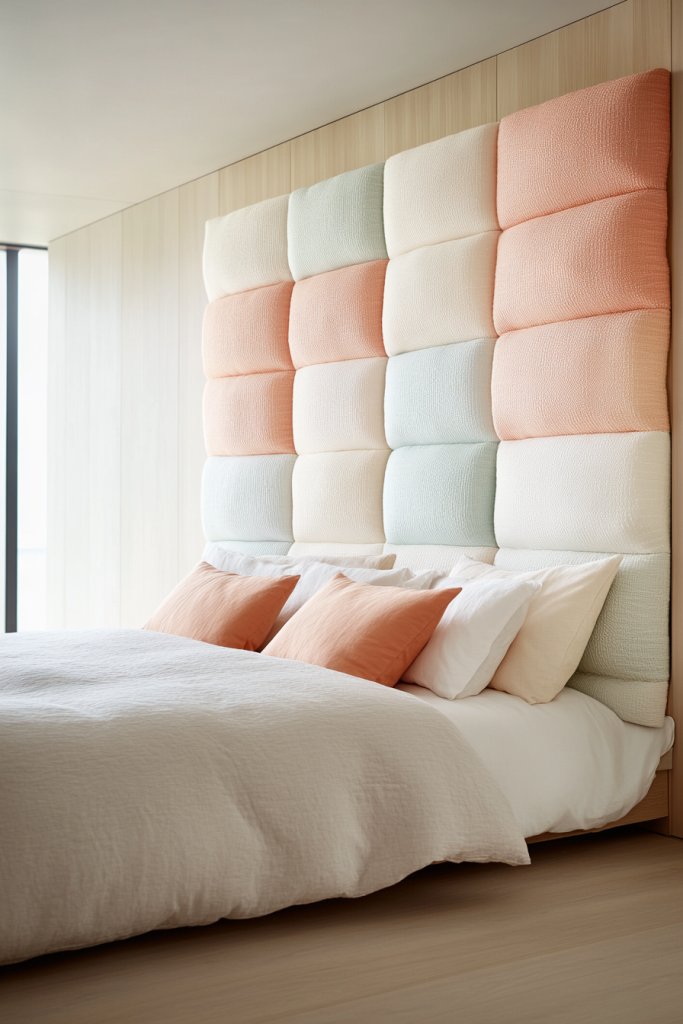
A plain bed frame can make a room look dull, especially in a shared space where personality matters. Creative headboards add visual interest, texture, and a sense of coziness. Fabric or wooden panels can be customized to reflect each child’s style, making the bed a focal point. How do you craft a headboard that’s both stylish and practical?
Imagine a soft fabric headboard in a playful pattern or a natural wood panel with carved details. The headboard extends slightly beyond the bed’s width, adding a layered, tailored look. Cushioned fabric headboards invite comfort, while wooden ones add warmth and texture. Decorate with small pillows or string lights for extra charm. The bed becomes a statement piece that sets the tone for the room.
Use different materials—soft upholstery, reclaimed wood, or painted MDF—to match your decor style. Incorporate themes through fabric patterns or carvings—like stars, animals, or geometric shapes. Adjustable or removable covers make cleaning and updates easy. For a minimalist look, opt for sleek, painted panels; for a cozy vibe, choose plush fabrics. Personalize with painted initials or decorative accents.
Start by measuring the bed and deciding on the headboard height. Build or buy a panel that fits your style and budget. Cover wooden panels with fabric, padding, or paint as desired, attaching securely to the bed frame or wall. Use screws or brackets for stability and safety. Add decorative elements or lighting as finishing touches. Regularly check for wear or damage and update covers or paint as interests change.
Let kids choose their favorite fabrics, colors, or themes for the headboard. Add embroidered initials, patches, or painted designs for a personal touch. Incorporate textured fabrics or layered materials for depth. Change covers seasonally or as tastes evolve, keeping the headboard fresh and engaging. It’s a creative focal point that grows with your kids.
A custom headboard transforms a basic bed into a personal sanctuary that sparks pride. It encourages creativity and ownership over their space. Kids feel more connected and comfortable in a room that reflects their personality. Ready to craft a headboard that’s both functional and fun?
20. Versatile Multi-Use Furniture for Limited Space
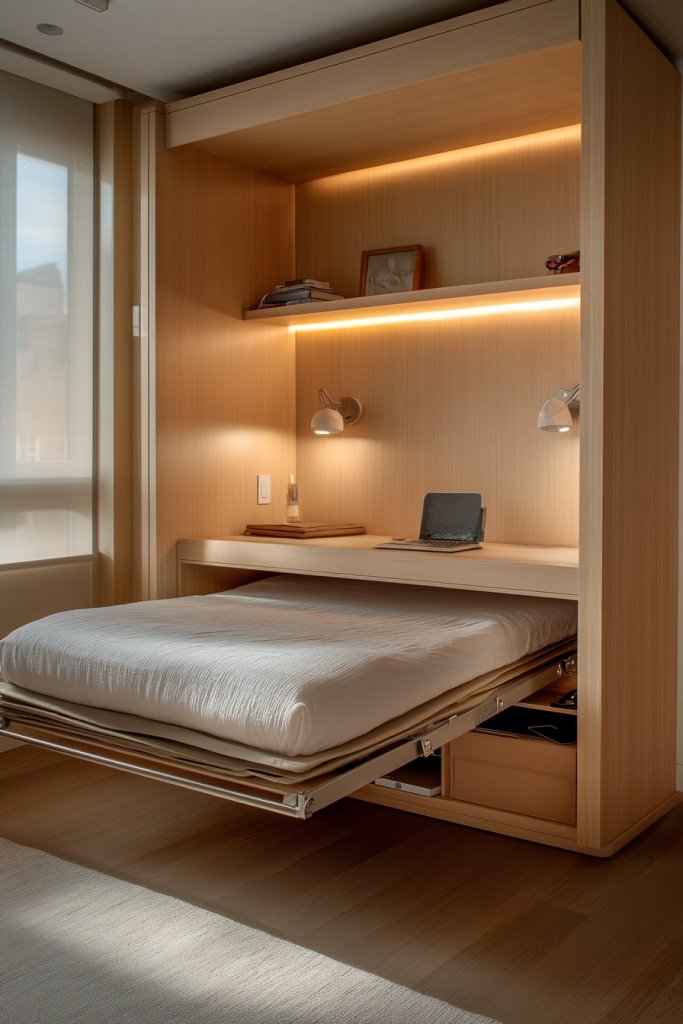
Limited space in a shared bedroom means sacrificing comfort and style. Multi-use furniture maximizes every inch, offering flexibility without clutter. Pieces like fold-away beds or combo desks and storage help create a functional, adaptable environment. But how do you choose furniture that’s both versatile and durable?
Picture a sleek wall bed that folds up during the day, revealing a play area or study zone. Or a desk that doubles as a storage cabinet, with hidden compartments for toys or supplies. These pieces blend seamlessly into the room, maintaining a tidy, open look. The furniture’s clean lines and smart design make the space feel larger and more organized.
Opt for foldable or extendable furniture—like Murphy beds, fold-down desks, or sofa beds—that adapt to different needs. Choose neutral or matching finishes to keep the room cohesive. Incorporate hidden storage or modular pieces to suit changing interests and activities. For small rooms, vertical designs or wall-mounted options save floor space. Mix styles to add personality while maintaining practicality.
Start by assessing your space and identifying priority functions—sleeping, studying, playing. Select multi-purpose furniture that fits your needs and style. Install fold-away beds or desks securely, ensuring safety and stability. Use organizational accessories—bins, drawers, or hooks—for hidden storage. Keep pathways clear and maintain regularly to keep the space functional. Consider professional assembly for complex pieces.
Let kids choose finishes or details—like paint, hardware, or fabric—to match their style. Add personal touches like themed handles or decals. Incorporate adjustable or modular elements that grow with your children. Use decorative cushions or throws to soften multifunctional pieces. These updates make the furniture feel personalized and fun.
Multi-use furniture teaches kids adaptability and responsibility—important life skills. It makes small spaces comfortable and versatile, boosting confidence in their environment. Seeing furniture that adapts to their needs encourages independence and creativity. It’s a smart choice for modern, space-conscious families—ready to upgrade your room?
21. Personalized Storage Cubes with Monogram or Color Coding
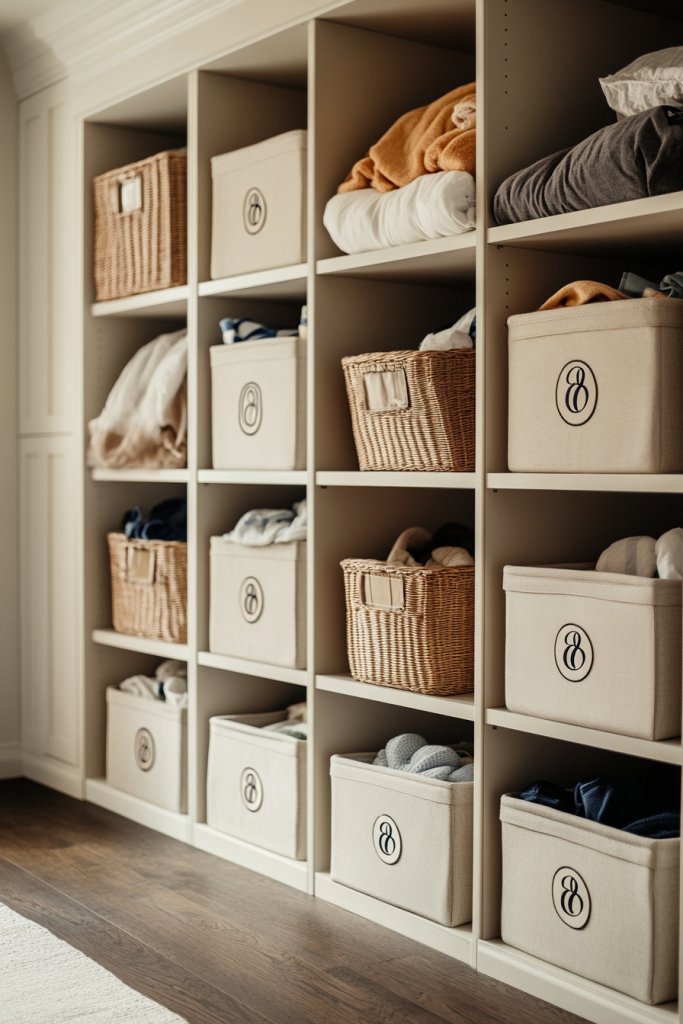
Keeping a shared bedroom tidy is a constant challenge, especially with multiple interests and toys. Personalized storage cubes help organize belongings while adding a touch of individuality. Monogramming or color coding makes it easy for kids to identify their space and take ownership. But how do you make storage both fun and functional?
Picture cubes in different bright colors, each with a monogram or icon representing the owner—like a soccer ball or star. Place them on shelves or under beds, creating a vibrant, organized display. Color coding helps kids quickly find and put away their belongings, reducing mess and frustration. The personalization makes storage feel special and engaging.
Use different sizes and shapes—square, rectangular, or even soft fabric cubes—for versatility. Incorporate labels or decals with initials or icons for easy recognition. Match the cubes to the room’s color scheme or themes—like ocean, jungle, or space. Add decorative trims, patterns, or textures for extra style. Rotate or update labels seasonally or as interests change.
Choose sturdy, lightweight cubes made of plastic, fabric, or wood. Personalize with stickers, paint, or fabric covers featuring initials or themes. Organize belongings by type—clothes, toys, or crafts—using color or label coding. Stack or arrange cubes in accessible spots—shelves, under beds, or closet corners. Encourage kids to put items back in their designated cubes daily for lasting order.
Let children select their favorite colors, fonts, or icons for their cubes. Add decorative features like bows, patches, or themed stickers for extra flair. Use initials or symbols to reinforce ownership. Incorporate matching storage bins or baskets for larger items, keeping everything coordinated. Seasonal or hobby-specific designs keep the system fresh and fun.
Personalized storage cubes teach responsibility and organization in a playful way. Kids learn to manage their belongings independently, boosting confidence. Seeing their name or icon on their storage makes them proud of their space. It’s a simple upgrade that makes tidying up easier and more enjoyable—ready to personalize your room?
Conclusion
These diverse shared bedroom ideas for boys and girls showcase how to blend personality and practicality seamlessly. Whether you prefer vibrant, lively themes or calm, neutral tones, these concepts will inspire you to design a space that your children will love. Don’t hesitate to try these innovative ideas in your own home—creating a harmonious, inviting environment is within your reach. Start today, and watch your kids flourish in their beautifully coordinated shared bedroom!
Leave a Reply